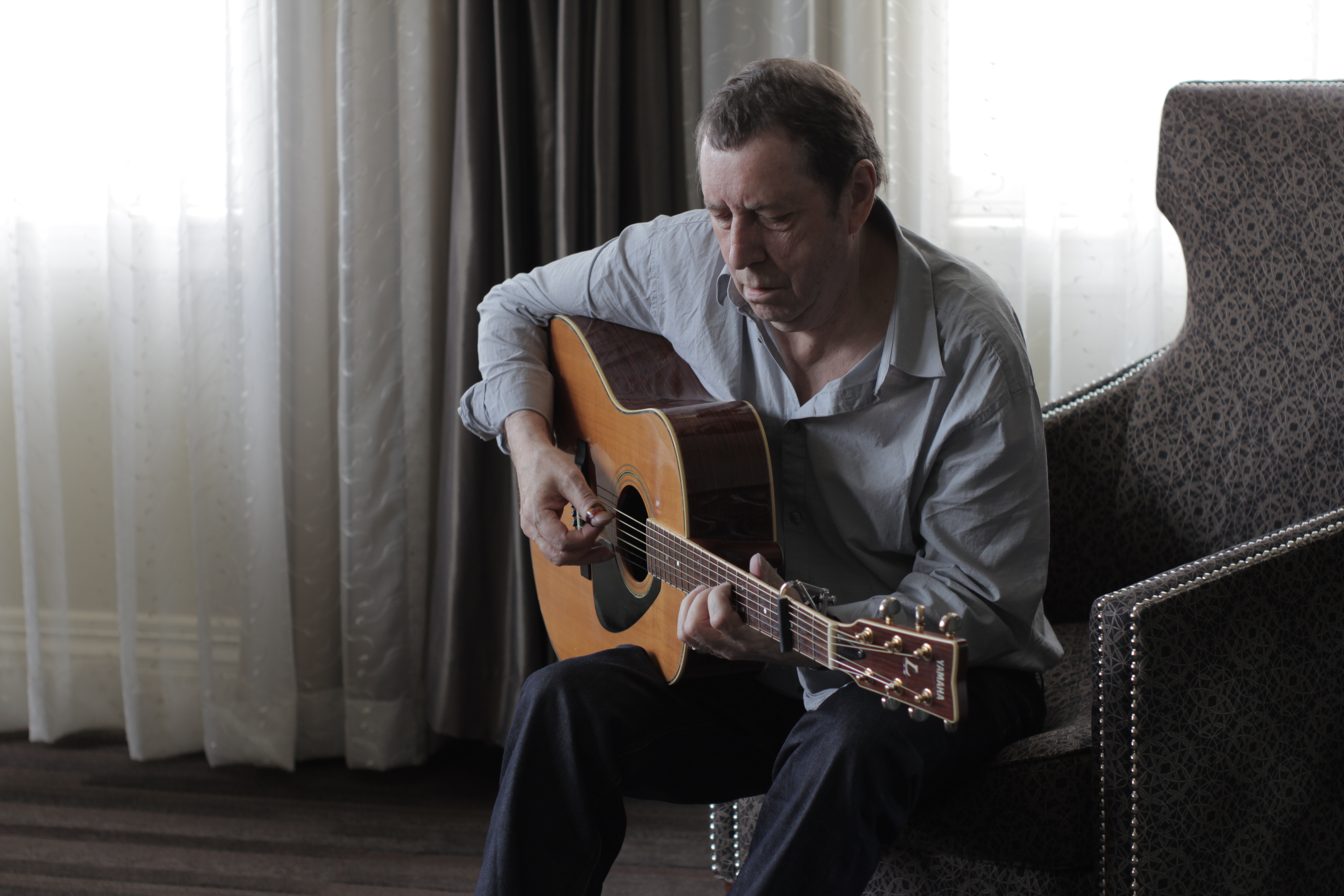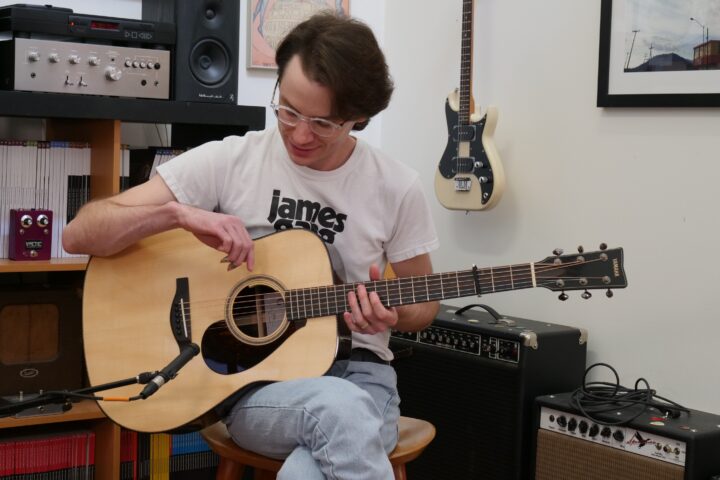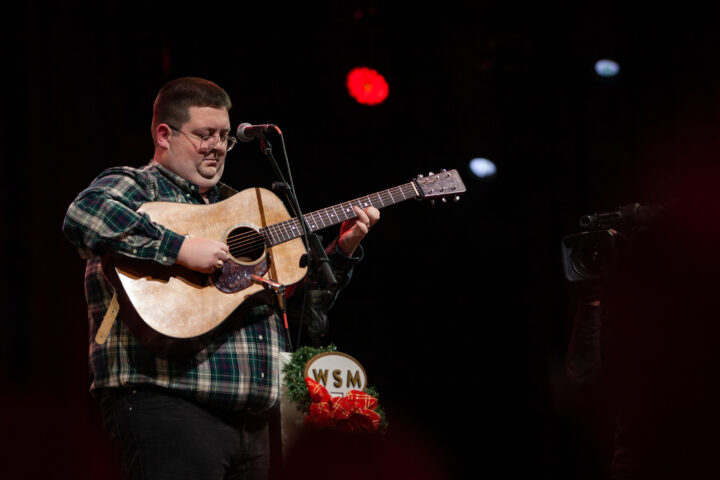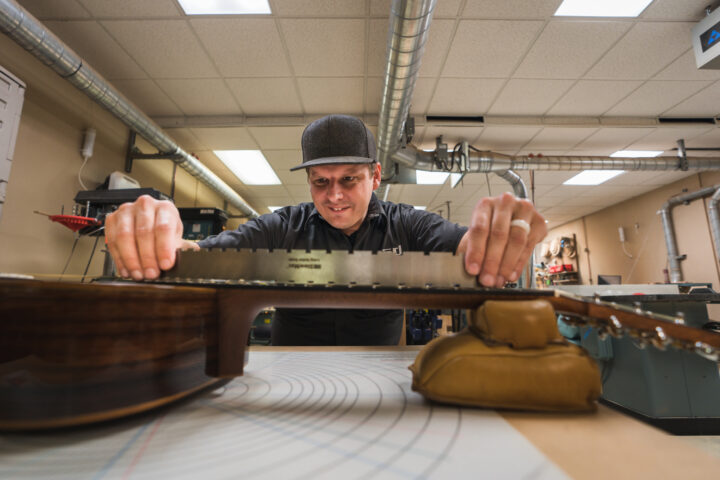Although he counts Big Bill Broonzy, Leadbelly and Brownie McGhee among his greatest influences, there is no mistaking Bert Jansch’s music as rooted in any place other than Britain. And while to the casual American observer he may seem to be quintessentially English, his demeanor and temperament more narrowly identify him with his Scottish heritage. The Celtic melancholy that suffuses his music has the same origins as Van Morrison’s–and all the great Scots and Irish poets and performers. His is a blues derived from the weight of poverty and oppression and a climate that makes men hard.
As the fingerstyle legend closes a supporting set for Neil Young at the Paramount Theatre in Seattle, he stoops and trots off discreetly, in the manner of some nocturnal predator (a sharp contrast to the Canadian’s leonine, swaggering stage exit). Nearly 50 years after he arrived as a teenager in London and set the folk-club scene on fire, Bert Jansch remains an enigmatic figure, his dexterity as a guitar player unrivaled and the beauty in his songs stemming almost entirely from their mournfulness.
Jansch was at the center of the 1960s movement often referred to as the “folk revival,” but it was something much more than a rehashing of ancient melodies and folktales for a larger audience with a love of hey-nonny-no and real ale. What he (and, later, his band the Pentangle) achieved was an authentic repackaging of acoustic music for the burgeoning album-buying market and the concert hall–retooling folk, blues and jazz for the more sophisticated palate in much the same way that the Beatles and the Stones had redefined popular music with reference to its American antecedents.
His first solo album, released on Transatlantic Records in April of 1965, sold an extraordinary 150,000 copies in the U.K. He was 19 when he recorded it, and Transatlantic bought it from him for a hundred pounds. Today he seems astonished that it has never been deleted. On a BBC documentary called Acoustic Routes, Billy Connolly, the former Scots folk hero and long the country’s most beloved comedian, holds up Jansch’s first record as the gold standard.
“This is the Bert Jansch ‘Blue’ album,” he mugs to camera. “This is a legendary piece. This was the ace album to have. Not only was the music extraordinary and original, but everyone wanted to look like this. They said, ‘How did he get to look like this and how can I buy some?’” The album did not just signify a breakthrough in recorded music but hinted at a different way of living.
Age and poor health have withered the sulky, sullen splendor of the tousle-haired lad depicted on that cover, but the gentle, lilting voice and boyish charm that made him irresistible to women is still there. When he hunches over his guitar, you are aware that you are in the presence of a master with few peers. Jansch remains bright, articulate and enthusiastic, and though soft-spoken, he clearly retains the hard man’s intolerance of fools learned from his uncle and the other denizens of the Scottish pub and club scene.
Six weeks before the Paramount gig, Bert Jansch was in Seattle headlining a show at the Triple Door, supported by Pegi Young and a band of alumni from her husband’s coterie of players. The relationship with the Youngs was forged in 2006, when Jansch, touring in support of The Black Swan album, found himself temporarily a member of Devendra Banhart’s band. Banhart, the young progenitor of what the press has dubbed “psych-folk,” had a spot on the bill at Neil Young’s annual Bridge School benefit concert.
Young invited Jansch to join him onstage for the opening number of the show, a rendition of “Ambulance Blues,” a haunting track from Young’s On the Beach. He had sidled up to Jansch moments earlier and indicated that the song was spawned by his love of the Scot’s music. Young showed him the chords, and Jansch had 10 minutes to rehearse and warm up. As Jansch contends, he was all but inaudible, but the starkness of the song is reminiscent of Jansch at his glummest.
As Young told the French magazine Guitare & Claviers in 1992, “I was especially taken by ‘Needle of Death,’ such a beautiful and angry song. That guy was so good. And years later, on On the Beach, I wrote the melody of ‘Ambulance Blues’ by styling the guitar part completely on ‘Needle of Death.’”
Elliot Roberts, Young’s longtime management partner, and Loren Jansch, Bert’s wife and manager, hatched a plan for Bert to tour with Pegi after the anticipated 2008 reunion of Pentangle. However, this was the U.S. tour that was canceled last year when doctors discovered, during a routine checkup, that Jansch had lung cancer. No stranger to health crises–shows had been canceled three years earlier to allow Jansch to undergo heart surgery–he buckled down with characteristic stoicism and, after a course of chemotherapy, is in full remission a year later.
The invitation to join Neil Young’s Twisting Road solo tour came with a suggestion that the dates with Pegi, who had a new album release, be reinstated. The tour with Young has put Jansch in front of a larger American audience than at any time since the early ‘70s, when he toured the U.S. with the Pentangle. As Jansch recalls, he and the band initially had an antipathy towards the States, even after they’d arrived for their first tour, in 1969.
“We were all a bit reticent about America,” he says. “There was not so much excitement about it as an aggression towards it. It was the music that we were drawn to.”
Jansch speculates that because a number of the band members were steeped in the jazz tradition, they identified more with jazz musicians than the colorful rockers and hippies with whom they shared billing. On those early trips to the States–chaperoned by their manager, Jo Lustig, a Brooklyn record-business hustler who had decamped to London in the early 1960s–they gravitated toward Harlem and Watts in their off time. Lustig had connections in the jazz world, and through him the band got to meet Miles Davis and many of their other idols.
On a tip from Mo Ostin’s guitar-playing son, the Pentangle was signed to Warner Bros. in the States. (Jansch doesn’t remember much about the band’s relationship with that dream team of record executives at the height of their powers, other than that bass player Danny Thompson went a few rounds of golf with Ostin.) The deal was largely around sales and promotion; A&R remained with the band’s British label, Transatlantic.
Warner supported frequent tours on which the quietest band on the planet was often matched with some of the loudest. They played on eclectic bills at Bill Graham’s Fillmore East and West, including a week of shows with the Grateful Dead. Jerry Garcia later remembered the British band as an influence on the Dead’s acoustic sets; Jansch, in turn, only remembers how stoned everyone was at the Dead shows. At the peak of their popularity, on their third tour, Pentangle played New York’s historic Carnegie Hall. It had been Jo Lustig’s ambition, but meant little to the band at the time. Although he would return many times, this also represented the peak of Jansch’s commercial success in the U.S.
The pace of touring–U.S. tours were always followed by European and Australian dates–and the unhealthy lifestyle took their toll. The Pentangle’s music called for incredibly high standards of concentration and skill; Jansch felt shackled.
“I’m surprised how much of the music we actually retained, you know, ‘cause it was quite complex stuff,” he remembers. “It was all arranged within the band, and some of the numbers were 20 minutes long. Some, like ‘Hunting Song,’ were such a precise thing.”
Jansch had had enough. At one stage, his frustrations had caused him to rail against the States in the weekly music paper, Sounds: “Under no circumstances will I return. All that madness and insanity, no thanks.” The members went their separate ways in early 1973, and although they would reunite as a unit and in various subgroup configurations, the mantle of guardian of the British folk tradition in the brave new frontiers of rock was handed over to Fairport Convention and its alumni. Jansch justifies the decision today: “Everybody had more to do than just Pentangle. Management was pushing us too far, too fast. No one ever got time to sit back and relax.”
—–
With the freedom of a solo artist again, Jansch quickly overcame his aversion to the States and between 1974 and 1981 made many trips to the U.S.–to record with American musicians and play solo dates. He lived for three months with Iain Matthews at Matthews’ San Fernando Valley house and remembers a long sojourn in Santa Barbara.
Signed to Tony Stratton-Smith’s Charisma label at the whim of its founder, the three records that Jansch made for the label have recently been reissued in expanded CD and vinyl versions. The first of these, L.A. Turnaround, is the most rewarding of any Jansch made after his Transatlantic tenure and before his rebirth in the late ‘90s. There is a warmth and vibrancy in Mike Nesmith’s production, and the pedal-steel contributions by the ex-Monkee’s longtime associate and celebrated guitar technician Orville “Red” Rhodes create a texture that ought to have broadened Jansch’s appeal beyond the purist folk market. (On the CD version of L.A. Turnaround, there is some priceless footage of Jansch, Nesmith and Rhodes working on the album and relaxing at Stratton-Smith’s plush English country manor.)
The follow-up, Santa Barbara Honeymoon, was recorded entirely on the West Coast, but the result was an album that is not one of Jansch’s favorites (the participants perhaps over-refreshed, according to the accounts of Charisma A&R head at the time, Pete Frame). In 1981, the booker at McCabe’s Guitar Shop in Santa Monica, John Chelew, and his brother invited Jansch back to L.A. to record with Albert Lee. The result was Heartbreak, one of the best albums in his catalog, the material a transatlantic potpourri that included some of the songwriter’s finest alongside traditional British tunes and inspired readings of “Heartbreak Hotel” and “If I Were a Carpenter.”
Jansch continued to play in the States, but the nature of the bookings and the absence of radio support did little to develop his audience. There was a successful tour with Ralph McTell in 1978, but there are no fond memories of the club circuit.
“In those days, the agent would just say, ‘All right, we’ll book a tour,’ and you’d have a set route, and, year-in, year-out, you’d take the same route following every other guitar player into the clubs, and it just went around in circles.” The process was not doing anything to promote record sales, and it ended up costing Jansch. He concentrated his gigging in Europe for many years.
It was during this time that Jansch wandered into an artistic and personal wilderness brought on by his relationship with alcohol. Although he had not touched a drop or even been in a pub before he was 17, the society to which he belonged was one that drank as a way of life. The annual New Year’s Hogmanay holiday was an excuse for all around him to get drunk for two days. He also had a boozing surrogate father whom he revered.
“My mother’s brother lived with us–he was a docker in Leith, and he had an alcohol problem,” Jansch explains. “He was a very, very quiet person until it came to Friday night, when he got paid. And from that point ‘til Monday morning, he was drunk. So I certainly knew about drinking really early on.”
Never a hell-raiser like old band mate Danny Thompson or fellow Celtic guitar virtuoso and songwriter John Martyn, Jansch had nevertheless been used to boozing it up on the road, before and after gigs, for 25 years. In 1988, on the road with bass player Rod Clements, he was admitted to the emergency room of Ashington Hospital, outside Newcastle, in the northwest of England. A doctor (who was also a fan) counseled him that if he didn’t stop there and then, he risked the demise of his acutely distressed pancreas and might have as little as a week to live.
Talking about it today, he recalls, not without a hint of pride, his drinking days and how he curbed the demon overnight, though he is reluctant to tie his issue with alcohol to his upbringing. He clearly has a strong attachment to the land of his birth and, when prompted by his wife, Loren, will suggest that he’d like to return at least part-time to Scotland.
“Edinburgh is home. It’s like everything in the world that should be is in Edinburgh and its surroundings.”
The physical and artistic renaissance that commenced when Jansch left drinking behind has continued to gather momentum. (He still has two bottles of beer as a pre-gig ritual, but that is all.) Of his contemporary American audience, he says, “It’s certainly growing. It’s much healthier than it was in the ‘70s and ‘80s.” The discovery by new generations of American guitar and folksong enthusiasts came about in part through the name-dropping by new folk-inspired artists like Espers, Devendra Banhart and Beth Orton. Back home, he has benefited greatly from the advocacy of British indie-rock guitar stars Johnny Marr and Bernard Butler, and in 2007, he played onstage with the English pop cause célèbre, Pete Doherty.
Jansch’s own shows are devoid of artifice, and his delivery absent any hint of performance, whether for a dedicated supper-club audience or a horde of rabid Neil Young fans, most of whom know nothing of him. This is music, not entertainment, and there are few jokes between numbers. His humility onstage reveals his Scottish disposition. It is not that he is shy about his talent; his demeanor could almost be mistaken for aloof. It is as if he would not risk his talent for the sake of a little showiness.
And he is always quick to give credit to his sources. Before his beautiful rendition of “Blackwaterside,” he cites Anne Briggs as the tune’s excavator. He talks about hard men before attributing “My Donal” to his old Scottish friend Owen Hand. Of course, there is always room for one of his Jackson C. Frank covers; Frank is simply introduced as one of his favorite singer-songwriters. Jansch stopped playing “Needle of Death” many years ago, deeming it too dark, but it is back in the set list for special occasions on this recent tour.
Jansch is deprecating about his talent as a writer; he denies having any cherished causes or a book of favorite themes from which he draws inspiration. Like myriad songwriters, he claims that the muse simply comes when it comes–and rarely when on the road. His best songs are self-reflective, about issues like his drinking or his travails as a rootless relationship-swapper.
Among all the songs of longing and regret, with their imagery inexorably tied to love gone wrong, peppered across his 23-album solo catalog are a few songs about the environment. Asked if he was conscious of a need to proselytize about pollution, for example, he says, “I’ve always taken note of the natural world around us, because we live in a world that’s not at all natural. It’s only when things like what’s happening in the Gulf of Mexico come along that it comes into focus, but there are things like that happening all around the world. People don’t write about it.”
The American tours of 2010 have raised Jansch’s profile to a level that befits the legend. As well as the solo headlining dates and the Twisting Road tour with Neil Young, he was on the bill at Eric Clapton’s Crossroads Guitar Festival in Chicago this past June. It’s only fitting, since it is as a guitar player that Jansch will be remembered. As Duck Baker believes, “Jansch was more of an influence on the fingerpickers of my generation than any of the American players.”
To hear Jansch talk about himself and his career, one gets the sense of a man who has never felt comfortable with the idea of his own celebrity; of a musician who has worked harder than any to refine his playing because, as he learned at home, hard work is its own reward and has little to do with a gold ring. He has whittled away at his art–turning the ideas that first came to him as a boy in Edinburgh, when he started building his own guitars, and fueled by the indelible impressions of the poets and singers and characters he met in the folk clubs–and created a timeless Celtic version of the blues.
It is a miniature, but its intricacy and heart are every bit as meticulous as the broad canvases that Neil Young paints. And while his presentation may seem less considerate of his audience, his legacy will loom over artists that follow just as powerfully as that of his superstar acolyte and champion.
Sober now for nearly 25 years and married to Loren for more than 10, he seems like a man who is living the happiest phase of his life. Jansch’s relief at having, once again, walked away from life-threatening illness is palpable. He seems almost content–a journeyman who has at last taken charge of what has been driving him, the blues no longer running the game.
—–
Odds and Sods
Bert Jansch’s checkered guitar history
When asked if he is sentimental about his instruments or whether they are simply the tools of a craftsman, Bert Jansch doesn’t answer directly.
“I have a collection of odds and sods; none of any value or note. I had such a checkered history with guitars. From the early days, I started by trying to make my guitars myself. Then my first boss–I was a nurseryman’s apprentice–sponsored me, and I went out and got a red Hofner ‘cello’ jazz guitar. I went down to the folk club and quickly realized it was the wrong guitar. Then I had a Lonnie Donegan Zenith, but six months after I arrived in London, it went missing. From then right up until after the first album, I did not own a guitar. When I did gigs, I’d go to the gig and borrow a guitar.”
His landmark first record was made with four or five different Martins borrowed from, among others, Martin Carthy. Once he could afford his own guitars, a John Bailey was among his early favorites and a stalwart of the Pentangle’s hectic touring days.Jansch also has a long relationship with Rob Armstrong, with whom he’s just done a signature guitar.
“I got to know Rob Armstrong quite well, because he’s a player himself. Him and his missus do the local folk clubs–she plays the double bass–but he won’t travel. Never goes further than Birmingham.”
In the late 1970s, Jansch tried his hand at retailing, opening the Bert Jansch Guitar Shop in London’s Fulham district. The enterprise started with the ambition of selling handmade British guitars, showcasing the craft of Jimmy Moon in Glasgow, among others, “but if we sold one every six months, we’d be lucky.” The business was wound up after two years. “That’s how I got involved with Yamaha. We sold Yamahas. Even though we went bankrupt, Yamaha have always been good to me.”
Jansch has played Yamahas for years. He started with an FG1500, and when he visited Red Rhodes’ store in West Hollywood, the guitar-electronics guru tricked it out, cutting a hole in the body to insert volume controls. The 1500 has long since been patched up and remains one of the guitarist’s favorites, but these days he almost exclusively uses an LL11E on the road, with an LL400 as backup.
“The pickup system that the LL has is one of the most natural I’ve heard,” he explains. “It’s got a piezo under the bridge–under the saddle–and it’s got a little contact mic.”
If he needs any work or modifications, Jansch goes to Celine Camerlynck, of Luthiers’ Corner on Denmark Street in London. “She does all my repairs or any alterations I need. I found her through my friend Paul Wassif from Glasgow. We had a resonator that needed some work, and she did work for a shop called the London Resonator Centre. I’ve gone to her ever since.”



